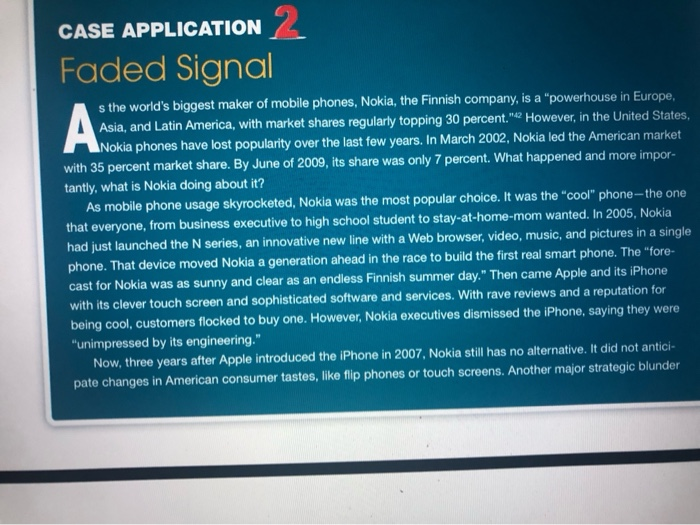CASE APPLICATION 2 Faded Signal A s the world's biggest maker of mobile phones, Nokia, the Finnish company, is a powerhouse in Europe, Asia, and Latin America, with market shares regularly topping 30 percent. "2 However, in the United States, Nokia phones have lost popularity over the last few years. In March 2002, Nokia led the American market with 35 percent market share. By June of 2009, its share was only 7 percent. What happened and more impor- tantly, what is Nokia doing about it? As mobile phone usage skyrocketed, Nokia was the most popular choice. It was the "cool" phone-the one that everyone, from business executive to high school student to stay-at-home-mom wanted. In 2005, Nokia had just launched the N series, an innovative new line with a Web browser, video, music, and pictures in a single phone. That device moved Nokia a generation ahead in the race to build the first real smart phone. The "fore- cast for Nokia was as sunny and clear as an endless Finnish summer day." Then came Apple and its iPhone with its clever touch screen and sophisticated software and services. With rave reviews and a reputation for being cool, customers flocked to buy one. However, Nokia executives dismissed the iPhone, saying they were "unimpressed by its engineering." Now, three years after Apple introduced the iPhone in 2007, Nokia still has no alternative. It did not antici- pate changes in American consumer tastes, like flip phones or touch screens. Another major strategic blunder was that its models were based on a European communications standard called GSM when roughly half the United States market used the CDMA (code division multiple access) format. One former Nokia executive said, "Nokia, at the height of its success, decided not to adapt its phones for the U.S. market. That was a mistake and they're still trying to recover from this." An executive at a North American network operator said, "The attitude at Nokia was basically: Here is a phone. Do you want it? Nokia wouldn't play by the rules here, and they have paid a price." That arrogant attitude and the global economic slowdown have continued to hurt the company's sales and earnings. Meanwhile, Nokia set up liaison offices in Atlanta, Dallas, Seattle, and Parsippany, New Jersey, cities where the top American operators have big business units. And it has recently revamped its U.S. operations to collaborate more closely with those major operators. For example, AT&T has begun billing its customers who use Nokia services, keeping those customers from receiving a second bill from Nokia. Best Buy began carrying a Nokia netbook, which is a model for its new collaborative strategy. Nokia also forged a deal with Qualcomm, the largest maker of mobile phone chips for CDMA devices in the United States. It also struck a deal with Microsoft to design Windows Office Mobile software applications for phones that use Nokia's Symbian operating system. Despite these efforts, however, some industry executives remain unimpressed. One analyst said, "They claim they get it and understand the U.S. market. But the execution still is not there." Mark Louison, president of Nokia's North American unit, who has a seat on Nokia's global management board, said, "In the past, we had a one-size-fits-all mentality that worked well on a global basis but did not help us in this market. That has changed now." The company recognized that its former strategy had not worked in North America and began trying to lay the groundwork for long-term success. Louison says, "Everything you see us doing is to build the broad set of capabilities to take us broader and deeper into the U.S. market." 2. Why do you think a "smart" company makes "dumb" mistakes? 3. What strategies is Nokia using to revitalize its North American business? 4. How could Nokia have done better at using strategic management? What does this case story tell you about strategic management









